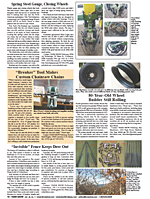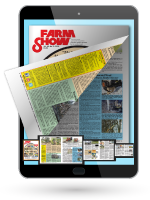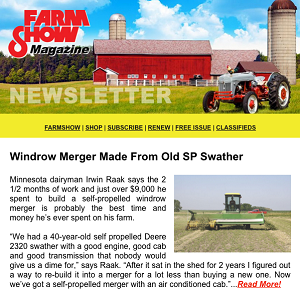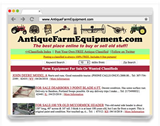You have reached your limit of 3 free stories. A story preview is shown instead.
To view more stories
(If your subscription is current,
click here to Login or Register.)
Center Pivot "Rut Filler"
When Brian Hoffner, Gill, Colorado, needed to fill ruts left by the center pivot irrigation system in a hay field three years ago, he figured he could save time and money by making a cart to do the job.
Hoffner bought an old road sand and salt spreading trailer from a local state highway maintenance department
..........
You must sign in, subscribe or renew to see the page.

You must sign in, subscribe or renew to see the flip-book
Center Pivot "Rut Filler" IRRIGATION Miscellaneous 27-2-8 When Brian Hoffner, Gill, Colorado, needed to fill ruts left by the center pivot irrigation system in a hay field three years ago, he figured he could save time and money by making a cart to do the job.
Hoffner bought an old road sand and salt spreading trailer from a local state highway maintenance department and went to work. The trailer, which holds about 10 tons of material, has a 16-in. wide conveyor in the bottom to drop material onto the fan. The sides slope in to the conveyor, so it empties out completely.
"It wasn't that difficult to convert it to fill ruts," he says. "It had its own engine to power a self-contained hydraulic system. Since I was going to use it behind a tractor, I took off the engine and hydraulic system and added hoses to couple it to the tractor."
He stripped off the spreader fan and then turned the box around on the trailer so he could see the opening from the tractor seat. Then he added a 2-ft. long flange on each side of the drop opening. "The flanges direct material into the tracks. I made them adjustable, so I can open or close them to fill narrow or wide tracks," Hoffner says.
"I hadn't seen anything like this before, but I knew it would work," he says. "After I used it to fill ruts in my fields, neighbors started asking if I'd fill ruts for them.
"It's become a small sideline business for me. I can use whatever material people want, from gravel to sand or soil," he says. "Gravel allows better drainage away from the wheel track, so ruts aren't as likely to form. I've found that if ruts are deep, I can fill them about two-thirds full with gravel and then the field can be tilled without disturbing the gravel base.
"Typically on half a sprinkler, it takes about 500 tons of material." That works out to a little more than 3 tons per acre, which means a 10-ton load will cover about 3 acres, depending, of course, on the depth of the ruts.
Hoffner charges $30 per 10-ton load to fill ruts, so at 3 acres per load, that comes out to about $10 per acre. The cost of the fill is not included.
He says the best time to fill is in the winter when the ground is frozen.
Contact: FARM SHOW Followup, Brian Hoffner, 30300 Road 57, Gill, Co. 80624 (ph 970 352-4654).
To read the rest of this story, download this issue below or click
here to register with your account number.





